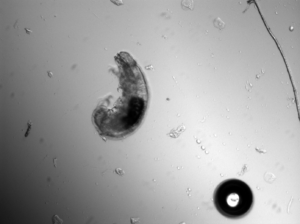 Memory refers to the storage of information across time. Historically, information storage in a biological system has been seen as requiring either a persistent structural or functional change at the cellular level. Whether a memory relies on a structural or functional alteration in neurons is a difficult question to address in most model systems as one cannot fully separate structure from function at the cellular and molecular levels. In this regard, tardigrades (water bears) become an important neuroscience subject. Tardigrades are microscopic multicellular organisms with a nervous system. They are special organisms in that they can enter a cryptobiotic state (referred to as a “tun” state) to survive exposure to hundreds of degrees celsius, absolute zero, complete dehydration, a complete vacuum, or even cosmic radiation. Metabolism ceases in this tun state. Thus, tardigrades can be used to separate the structural and functional contributions to memory because all neuronal dynamics can be stopped and restarted during the storage phase. We recently showed that tardigrades display classical (Pavlovian) conditioning and can be fear conditioned to associate a blue light with an electrical shock. We are working to instill long-term memories in these animals and to develop an efficient means to induce tunning and revival. When all of the pieces are in place, we will test the importance of on-going metabolism for memory storage.
Memory refers to the storage of information across time. Historically, information storage in a biological system has been seen as requiring either a persistent structural or functional change at the cellular level. Whether a memory relies on a structural or functional alteration in neurons is a difficult question to address in most model systems as one cannot fully separate structure from function at the cellular and molecular levels. In this regard, tardigrades (water bears) become an important neuroscience subject. Tardigrades are microscopic multicellular organisms with a nervous system. They are special organisms in that they can enter a cryptobiotic state (referred to as a “tun” state) to survive exposure to hundreds of degrees celsius, absolute zero, complete dehydration, a complete vacuum, or even cosmic radiation. Metabolism ceases in this tun state. Thus, tardigrades can be used to separate the structural and functional contributions to memory because all neuronal dynamics can be stopped and restarted during the storage phase. We recently showed that tardigrades display classical (Pavlovian) conditioning and can be fear conditioned to associate a blue light with an electrical shock. We are working to instill long-term memories in these animals and to develop an efficient means to induce tunning and revival. When all of the pieces are in place, we will test the importance of on-going metabolism for memory storage.
Metabolic Necessity for Memory Storage in Tardigrades
- Home
- /
- Metabolic Necessity for Memory Storage in Tardigrades
